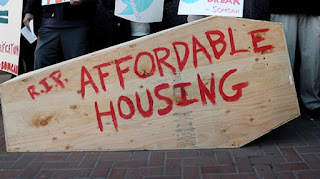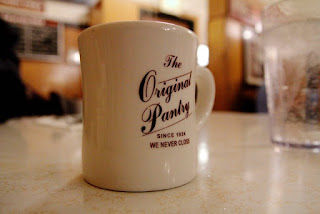Wendall--every other Thursday
I was particularly heartbroken last week by this Los Angeles news headline: “Chinatown renters rally against 300% spike in rent.”

Can anyone afford a 300% increase in anything?
First of all let’s just start with the nightmare, for anyone, of being faced with that kind of increase in monthly expenses. To make matters worse, the building in question has been part of an affordable housing program for the last thirty years, with tenants who’ve lived there for decades. It currently houses 124 families, many who receive Section 8 supplements.
This rent increase is, in effect, according to several tenants interviewed by the LA Times, an eviction. Given the current rental market, few of the residents will be able to stay close by, and some may even be forced to join the 60,000 people already
living on the street in Los Angeles County.
In doing a bit more reading, I found the struggle to fight this increase has been going on for three years. To its credit, the Los Angeles City Council made an effort to buy the building, but the owner refused to sell to them. Last week, renters marched to Mayor Karen Bass’s house and slept outside overnight. She is sympathetic to their plight, but her options are limited because the building is privately owned.
Now that housing in downtown LA has become out of reach for almost any renter, it follows that developers and landlords would set their sights on “up-scaling” nearby Chinatown, just over the 101 Freeway from City Hall and the Los Angeles Cathedral, and nestled between Dodger Stadium and Union Station.

The site of my first job in LA.
Before I came west, my only association with this neighborhood was via the film Chinatown, which is, of course, fictional. But my first job in Los Angeles was close by—working as a telemarketer for the Mark Taper Forum Theater. I was absolutely wretched at it, and was filled with dread every time I drove to the Center Theater Group offices on Temple St. where I was forced to interrupt patrons’ dinners to ask for money. Horrors. I only lasted a month. But it was long enough to fall in love.
In 1986, downtown was something of a ghost town and there were only a few restaurants to go to after work. There was the dearly departed Gorky’s, a Russian diner, complete with kielbasa omelets, The Original Pantry, established in 1929, which before the pandemic, had never closed its doors, and the famous Pacific Dining Car, which was well out of my budget then and is now, sadly, gone as well.

A souvenir from the much-missed Gorky's
 |
| The Original Pantry mug. We have a few in the cupboard... |
 |
| A photo from the one time I got to visit the Pacific Dining Car |
Then, I looked the other direction and spotted the neon lights of ABC Seafood and Yang Chow. It was no contest. For someone raised in North Carolina in the 70s, where Chinese food was hard to find, I was in heaven. Even now, all these years later, Yang Chow is still my go to restaurant for my birthday.

There are so many great restaurants in these few blocks, but this is my favorite.
In the last few years, I’ve seen more and more Chinatown businesses pushed out by rent increases. If any of you are Michael Connelly fans, one of Harry Bosch’s favorite haunts and an LA institution, Chinese Friends, closed last year.
Greed and gentrification have always been with us, but in Los Angeles, they seem to operate on hyper-speed. The city has almost no respect for its own history, and the number of “tear downs” and culturally important landmarks that have been razed just in the thirty-seven years I’ve been here is staggering.
But the takeover of Chinatown is particularly heartbreaking, because in this case, it’s happening for a second time. The original Chinatown, established in the early to mid-nineteenth century, not only suffered the horrendous Massacre of 1871 (another post for another time), but was taken over and destroyed by the city in the late 1930’s to build Union Station.
L.A.'s Old Chinatown circa
1930s.
It turns out that Chinatown was very specifically set in and designed to reflect 1937, just before the buildings were all torn down. Every member of that community was relocated in the service of “progress,” and a “New Chinatown” was opened and dedicated in 1938/39. Again, imagine experiencing this kind of displacement.

The West Gate of the new plaza, circa 1939 (Los Angeles Public Library Collection)
Since at that time, only second generation Chinese citizens were allowed to own property, the center of the “new” location approximately a mile north of the original, was initially developed by the American born Peter Soo Hoo, the first Chinese-American engineer for the Department of Water and Power. He and a group of investors bought a local railyard and turned it into a “pedestrian plaza,” in actuality one of the first “shopping malls” in the U.S. That plaza is still there, though several longtime vendors and restaurants have recently gone.
If this rebuilt and resilient neighborhood goes the way of much of the city’s new cookie-cutter, overpriced, mixed-use buildings, it’s hard to imagine where the community might re-invent itself within city boundaries.
It’s a familiar story, but always a tragic one, since the strength of Los Angeles has always been the talented and generous people who’ve chosen to live here and establish so many strong international communities and neighborhoods. What is the city, without them?
There is only one building left from the original Chinatown. Since 2003 it has housed the Chinese American Museum (425 N. Los Angeles Street), which is very much worth a visit if you’re in the area.
Today my agenda includes a donation to the Chinese Historical Society of Los Angeles, and a double order of Yang Chow’s slippery shrimp.


















Fascinating but very sad post, Wendall. Being pushed out and priced out is happening everywhere, including the UK. We have listed building regs over here which prevents historically significant buildings being torn down or modified too far from their original condition. What is the situation with that type of property in LA?
ReplyDeleteThe rights of tenants have been recently reinforced here, too, but I was listening to a BBC Radio 4 programme only recently about some private landlords using all kinds of underhand tactics to try to 'persuade' tenants to leave of their own accord.
Hi Zoe. It takes years and years to get a building protected in LA and there are at least five of them I know of personally that were listed then torn with an "oops, we didn't know" excuse. In terms of rent control, it is limited and only exists in certain pockets of the city. There's been a freeze during the pandemic, but I shudder to think what's going to happen when that's lifted in June. We are also suffering from a former Mayor who encouraged rampant development for housing only billionaires can afford. Although the citizens always vote for more money for affordable housing and funding to help the unhoused, it never seems to get used. We fight on, I guess.
DeleteIt's amazing and disturbing to see places and areas that foreigners regard as landmarks being pushed aside in the course of progress - here read "greed".
ReplyDeleteHi Michael. Yes, it is heartbreaking. I know it happens everywhere, but in my experience, LA is particularly careless and unfeeling about landmarks, particularly about "old Hollywood" places that you would think would be the bread and butter of the tourist industry. There are so many places that were still here in the 80s when I arrived that are gone. That's why all my short stories are set in the early 90s in LA, so I can go back!
DeleteThat is sad to hear. In my 20s, Madame Wong's was regular hangout. I saw so many amazing bands there. I remember Gorky's fondly. Later, we lived in Los Feliz and spent a lot of time in Chinatown. We'd often go there for Dim Sum brunches. And mooncakes in the Fall.
ReplyDeleteHi Haris, thank you for posting. Yes, many great nights at Madame Wong's and Dim Sum at the Empress Pavillion, which is closed now, too.
ReplyDeleteWendall, I remember Manhattan in the days before Rent Stabilization was "modified." The spirit of the city changed after that, as the young moved to new neighborhoods in search of manageable rents. Developers saw them as their pioneer scouts, sniffing out the next cool place to live. That triggered property assemblages and new construction to house the monied sorts desiring to live in the next chic locale...ultimately (again) driving out those who could not afford the new prices. It's a cycle playing out in practically every big city.
ReplyDeleteEven those who once were slaves in Egypt finally made it to the Promised Land after 40 years of wandering in the desert ... but I wouldn't bet on them being as lucky these days.
Hi Jeff - I remember this happening in Manhattan, as I was there a lot and had a lot of college friends in the East Village back in the day. I do think it's endemic in urban areas, but that doesn't make it any less sad. And yes, it is a decline indeed from the Promised Land to Encino...
ReplyDelete